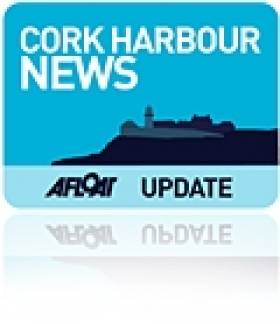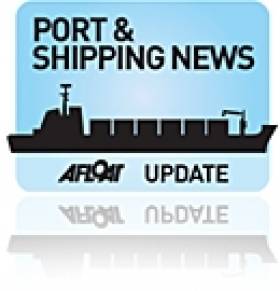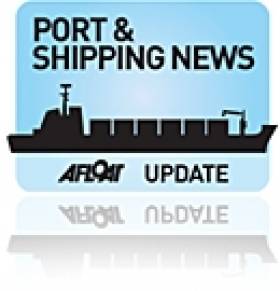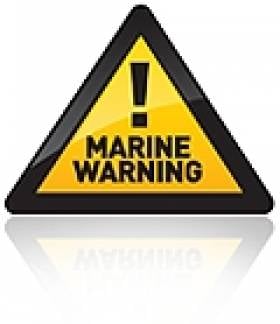Displaying items by tag: Galway Bay
Two Rescued in Galway Bay After Powerboat Breakdown
BreakingNews.ie reports that a Galway lifeboat rescued two men from a powerboat in Galway Bay yesterday afternoon.
The men were found drifting close to rocks after their 19-foot broke down south of New Harbour shortly after lunchtime.
The Irish Coast Guard Rescue Helicopter and the RNLI Lifeboat responded in minutes to the men's distress call.
Galway Bay Penthouse Could Be the Perfect Getaway
A penthouse apartment in a classic Georgian house on the shores of Galway Bay is now on the market.
Boasting "breathtaking views from every window" according to the Galway Advertiser, the penthouse at Barna House covers the entire top floor of the restored building on around 30 acres of woodland and sweeping lawns beside Rusheen Bay.
Inside the property comprises an entrance hall with cream Travertine tiled floors, high ceilings and moulded cornices; a bedroom wing with two large double bedrooms and two bathrooms, plus an adjoining drawing room that could serve as a third bedroom; and a spacious living and dining area with an "unusually large" kitchen, fully fitted with high gloss light cream units and granite worktops complete with top-of-the-range Neff appliances and burnished walnut floors.
The Galway Advertiser has more details HERE on this "mint condition" property, which is available through James Heaslip at Property Partners Maxwell Heaslip & Leonard (Tel: 091 565261) with an AMV of €650,000.
Crowds Come Out for An Tóstal Revival
Currach teams from around Ireland came together in Galway Bay last weekend for the revival of the An Tóstal Fesival, the Irish Times reports.
Up to 10,000 spectators are believed to have watched the nine Galway hookers brave the winds over two days of sailing in the event, the first in almost 50 years.
Members of the winning currach team from 1955 An Tóstal were also on hand for the opening ceremony.
The Irish Times has more on the story HERE.
1720 European Championships to be Launched on the Lee
The 1720 Sportsboat European Championships and the class national championships will be launched at a "Sailing By The Lee" event on Friday 29th April, 2011 where six 1720's will be raced on the River Lee adjacent to the Headquarters of the Port of Cork. The boats will be brought up river on the Thursday evening and racing will commence at lunch time on the Friday (see below for the Eddie English weather video) which say the class will provide photo and media opportunities at the new marina in the Port of Cork. Each boat will carry sponsorship flags.
In June up to 20 boats go back to their roots when the fleet gathers at Royal Cork Yacht Club for the CH Marine Sponsored National Championships.
A fleet of between 30-35 boats will contest the Corona sponsored Europeans when they set sail off Baltimore in September. There are already confirmed entries travelling from Scotland, Isle of Man, England and Wales while there is also interest coming from Holland where a fleet of eight boats is currently active.
The robust Irish 1720 design has been celebrating a comeback in recent years after cheating death by atrracting a strong following in West Cork, spearheaded by some of the rebel county's top sailors.
The fleet is rapidly becoming the most popular one design keel boat in this part of Ireland. There are now established and growing fleets at Royal Cork, Crosshaven, Kinsale, Baltimore and Schull while Galway Bay also has a growing fleet, racing in Galway Bay. The 2010 Nationals attracted a fleet of over twenty boats,
The series itself will be sailed over a three day period starting on Thursday, 1st September and consisting of nine races in total, three per day. Notice of Race and Entry Forms will be available shortly from Baltimore Sailing Club.
Good Friday in Galway as Second Ferry is Loaded
Despite freshening winds the 169 gross registered tonnes ferry was winched out of the waters of the port's Dún Aengus Dock. In total the operation took six-hours which saw the delicate positioning of the 27m long ferry between the ship's two deck-mounted cranes and lowered onto the cargo-deck.
Yesterday proceedings to load the ferry were suspended due to delays in relocating other cargo so to accommodate the 243 passenger capacity ferry. This followed the loading of her sister Clann na nOileáin on Wednesday.
Several previous attempts to hoist the Clann Eagle I onto the deck of the Danish-flagged vessel have been hampered. At one stage due to complications in efforts to transport the vessels, the 100m Thor Gitta was temporary detained by the admiralty marshal.
Procedures to load the 29 knots fast-ferry pair have been beset with incidents notably the grounding and subsequent damage to the first chartered cargoship, Patanal, off Rossaveal. It was originally planned to sail the ferries out into Casla Bay where the German-flagged vessel would load them onboard.
As a consequence the ferries were transferred to Galway where the Clann na nOileáin did not escape attention either. On the first attempt to load the ferry one of the ship's slings snapped from the crane-cradle causing the 172 tonnes ferry to fall into the water.
Minor damage was caused to the ferry, though three men who remained onboard at the time of the incident were taken to hospital but were later released.
Last month the ferries were sold to a French buyer after the company that owned them Bád Arann Teoranta (trading as Aran Direct) went into receivership. The ferries operated on several routes between Rossaveal to the islands but are now destined to serve on an inter-island service from the Indian Ocean island.
First of Two Ferries Loaded in Galway
The Clann na nOileáin was first loaded onboard this morning whereas her sister Clann Eagle I will be hoisted this afterrnoon. It is expected that this procedure will take around four hours to complete.
The 234-passenger ferries have been the centre of attention since two previous attempts proved unsuccessful following incidents in the mid-west port.
On the first attempt that took place nearly a fortnight ago, three men onboard the ferry were injured when the ships's crane-sling snapped when handling the 170 tonnes ferry Clann na nOileáin.
Fortunately the ferry was hanging over the water and splashed into Dun Aengus Dock rather than landing on the hold of the 4,078 gross tonnes cargo-vessel Thor Gitta. In the second attempt last
Saturday one of the cargoship's cranes sounded a safety alarm which halted proceedings.
The Danish-flagged Thor Gitta is the second heavy-lift cargoship that has been called in to assist in transporting the two former Aran Islands fast-ferries. The 100m cargoship is owned by Thor Rederi A/S of Svendborg and is expected to depart Galway tommorrow morning.
The first heavylift vessel the German-flagged Patanal grounded in rough seas after dragging its anchor in Casla Bay at the entrance to Rossaveal, where the ferries were originally based in readiness for loading.
Patanal suffered hull damage and was taken into Galway Bay for preliminary repair work. Last week the 7,002grt vessel operated by Harren + Partners, departed the bay to undergo further repairs at a dry-dock in Bremerhaven.
Aran Island Fast-Ferries Sold to Mauritius Operator
The sale follows a previous attempt to dispose of the 234-passenger capacity ferries at an auction in Galway last month. Despite bids reaching €950,000, they were withdrawn at the auction which was also hosted by the Cork based auctioneer.
The vessels remain in Rossaveal but they will be transferred onto a cargoship as 'deck-cargo' to make the long delivery journey across the high seas for the new owners. Mauritius is neighboured by the smaller islands of Agalega, Cargados Carajos and Rodrigues which together form the Mascarene Islands, with the French island of Réunion some 200km to the southwest.

Sisters Clann na nOileáin and Clann Eagle I moored at Rossaveal. Photo
Jehan Ashmore / ShipSNAPS
With a streamlined aluminium 26m mono-hull design the vessels are capable of 19.7 knots. When the craft were constructed in 2006 they were worth between €5 and €6m. The pair were built in France by the OCEA boatyard at Les Sables d'Olonne, on the Bay of Biscay coastline, for Bád Arann Teo (trading as Aran Direct).
The company which went into receivership, operated on routes between Rossaveal and the Aran Islands (Oileáin Árann) of Inishmore (Inis Mór) Inishmaan (Inis Meáin) and Inisheer (Inis Oírr).
In recent years, Aran Direct had intended to introduce a larger passenger-only catamaran ferry on a new route between Galway and Kilronan, the capital of Inishmore and the largest of the three islands.
The fast-craft catamaran envisaged for the route was the U.S. based, 37m Harbour Lynx (2003/427grt) formerly Angel of Freedom, with a capacity for 300 passengers.To be renamed Aran Princess, the vessel was scheduled to take only an hour's passage time across Galway Bay.
In addition the revived route would have been the first direct 'passenger' carrying link between Galway City to the Aran Islands, since the closure in 1988 by CIE (Córas Iompair Éireann) of the three-hour route operated by the Naomh Éanna (1957/438grt).
Cruise from Kinvara to Tahiti Wins Sailor of the Month Award
Recognised by the senior offshore sailing organisation, the Irish Cruising Club, with the award of the historic Faulkner Cup, the Quinlan's achievement is further enhanced by the fact that, in their determination to acquire a boat suitable for long distance voyaging, they built their steel-constructed 40ft cutter Pylades themselves, launching in 1997.

They have brought a lively and enquiring eye to the complex project, something which reflects Fergus's qualifications as an architect. As he has drily observed himself, there isn't a lot of work around for architects in Ireland at the moment, so everything clicked with the boat sea-tested and ready to go off on this sail of a lifetime.
Having left Kinvara in June 2009, their longterm plan is a global circumnavigation, returning to Galway Bay in August 2012. Quite what Ireland will be like by then is anybody's guess. But as it is, the crew of Pylades have enough to be getting on with in dealing with the vagaries of the open ocean, and the volatile political situation in some of the areas where ocean voyagers go. For armchair sailors at home, their thoughtful and entertaining reports on their experiences make them worthy "Sailors of the Month".
Fishing Exhibition Show Heads for Galway
The exhibition times are Friday 4th March (10:00am - 5:30pm) and on Saturday 5th March the opening hours are repeated (10:00am - 5:30pm). For further information on the trade-only show Tel: (053) 74 954 8037 / 954 8935 or by clicking here
Coastal Flooding Risk Warns Irish Water Safety
Flood conditions expose the public to hazards they need to be aware of. Fast moving water can exert pressure of up to four times its speed against the legs of someone attempting to cross it. Because water displaces bodyweight, the deeper a person becomes immersed the less the person weighs so the more difficult it is to remain upright. Never put ones feet down if swept away in floodwater, because foot and body entrapments and pinning are the leading cause of accidental death in rivers and fast flowing water.
Motorists need to be vigilant to avoid flooded areas on roads but particularly near rivers; with poor light and short days it is not possible to determine the depth of floods easily. Swift water will carry cars and other vehicles away and there have been very tragic drownings in the past as a result.
Children are naturally curious about water, therefore parents should caution them that floodwater hides the true depth and that manhole covers may be open and that small streams when swollen are very fast and deeper than normal.
What should I do when I hear a Flood Warning?
· Listen to the national and local radio for met eireann updates and AA Road watch updates
· Check on neighbours particularly if they are elderly, infirmed or families with young children
· Move your vehicles to higher ground
· Move animal stock to higher ground
· Check your small craft to ensure they are well secured or moored
· Make sure you have warm clothes, food, drink, a torch and radio.
· Block doorways and airbricks with sandbags or plastic bags filled with earth. Floodgate products will also work effectively.
· Switch off gas and electricity supplies if flooding is imminent.
· Check the time of High Water in the Newspaper or on http://easytide.ukho.gov.uk/EASYTIDE/EasyTide/SelectPort.aspx
· Check out www.flooding.ie for more detail on General flooding
Personal Safety
· Avoid flood waters at all times
· carry a mobile phone at all times in case you need to call for help - call 112 in emergency
· Wear suitable protective clothing & a lifejacket on or around water
· Do not enter fast flowing water.
· Never put your feet down if swept away by fast flowing waters
· Flooding on roads will be deeper at dips and around bridges.
· Stay away from sea and flood defences.
· when walking or driving, be aware of manhole covers and gratings that may have been moved due to the heavy flow of water.
· Take care when using electric appliances in damp or flood conditions.
· Remember that during the hours of darkness the dangers are multiplied.
After the flood
· Avoid eating food that has been in contact with flood water.
· Run water for a few minutes and wash your taps.
· Check gas and electricity supply.
· Leave wet electrical equipment alone to dry and have it checked prior to use.
· Ventilate your property well.
· Check on elderly neighbors.






































































